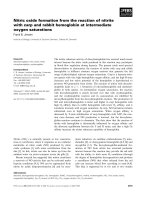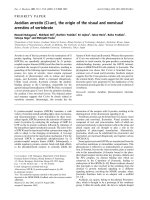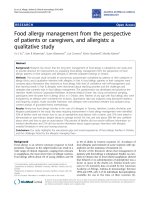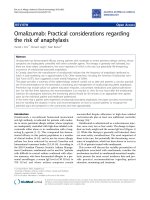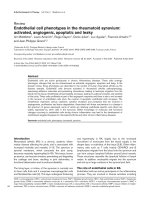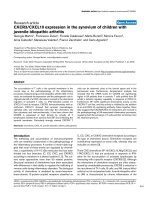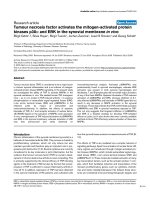Báo cáo y học: "Food allergy management from the perspective of patients or caregivers, and allergists: a qualitative study" docx
Bạn đang xem bản rút gọn của tài liệu. Xem và tải ngay bản đầy đủ của tài liệu tại đây (237.81 KB, 5 trang )
RESEARC H Open Access
Food allergy management from the perspective
of patients or caregivers, and allergists: a
qualitative study
Ya S Xu
1*
, Sam B Waserman
2
, Susan Waserman
3*
, Lori Connors
3
, Kristin Stawiarski
4
, Monika Kastner
5
Abstract
Background: Research has shown that the long term management of food allergy is suboptimal. Our study aims
to provide direction for improvement, by evaluating food allergy management from the perspective of, food
allergic patients or their caregivers, and allergists in selected outpatient settings in Ontario.
Methods: This two-part study included an anonymous questionnaire completed by patients or their caregivers in
allergy clinics, and a qualitative interview with allergists. In Part A, food allergic patients or their caregivers were
surveyed about information they received on food allergy, their level of confidence with self-management, and
their learning needs. In Part B, allergists were interviewed about teaching priorities and the challenges and
strategies that currently exist in food allergy management. The questionnaire was developed and piloted at the
Hamilton Health Sciences Corporation-McMaster University Medical Center Site. Using convenience sampling,
participants were recruited from 6 allergy clinics in 5 Ontario cities. Patients of any age with food allergy who were
evaluated by an allergist were considered for inclusion. Quantitative data was analyzed using descriptive statistics
and frequency analysis. Audio recorded interviews with allergists were transcribed verbatim and analyzed using
content analysis of grounded theory methodology.
Results: Ninety-two food allergic families in the care of 6 allergists in Toronto, Hamilton, London, Kitchener, and
Kingston participated in the study. Key areas requiring improvement in food allergy management were identified:
33% of families were not shown how to use an epinephrine auto-injector with a trainer, only 57% were asked to
demonstrate an auto-injector, despite being on average at their 5th visit, and only about 30% felt very confident
about when and how to give an auto-injector. Fifty percent of families did not receive sufficient information on
medical identification and 21% did not receive information about support groups. Interviews with allergists
revealed limitations in time and nursing resources.
Conclusions: Our study highlights the educational gaps and overall experiences of food allergic families in Ontario,
and the challenges faced by the allergists managing them.
Background
Food allergy is an adverse immune response to food
protein(s). Exposure to the culprit food(s) can result in a
wide range of clinical responses, ranging from urticaria
to anaphylaxis, the most severe form of allergic reaction.
Food allergy affects about 5% of young children and 3%
to 4% of adults in western countries [1]. Avoidance of
food allergens and treatment of acute reactions with epi-
nephrine are the mainstays of treatment [1].
Review of the literature shows that management of
patients with food allergy is suboptimal. Studies on mor-
tality in Ontario due to food related anaphylaxis showed
that delayed or no administration of epinephrine was a
factor in many of the deaths [2]. Similar trends were
seen in US mortality data recorded by the American
Academy of Allergy, Asthma & I mmunology: between
1994 and 1999, only 3 of 32 individuals had epinephrine
available for use at the time of their reaction [3].
* Correspondence: ;
1
Department of Pediatrics, McMaster University, Hamilton, Ontario, L8N 3Z5,
Canada
3
Department of Medicine, McMaster University, Hamilton, Ontario, L8N 3Z5,
Canada
Full list of author information is available at the end of the article
Xu et al. Allergy, Asthma & Clinical Immunology 2010, 6:30
/>ALLERGY, ASTHMA & CLINICAL
IMMUNOLOGY
© 2010 Xu et al; licensee BioMed Central Ltd. This is an Open Acces s article distributed under the terms of the Creative Commons
Attribution License (http://creative commons.org/licenses/by/2.0), which permits unrestri cted use, distribution, and reproductio n in
any medium, provid ed the original work is properly cited.
A subsequ ent study found t hat of the 31 additional
deaths between 2001 and 2006, only 4 individuals had
epinephrine administered in a timely manner [4]. A
recent systematic review investigating gaps in anaphy-
laxis management found 202 gaps. Deficiencies were
demonstrated in knowle dge and appropriate manage-
ment of food allergy at multiple levels i ncluding physi-
cians, patients, and their communities [5]. Practical
strategies are needed to address these numerous gaps.
Our study aimed to provide direction for improve-
ment in outpatient management by examining the
experiences and educational needs of food allergic
families, and the challenges faced by the allergists mana-
ging them.
Methods
Study design
This was a two-part study consisting of an anonymous
self-administered questionnaire completed by patients
with food allergy or their caregivers (Part A) and a qua-
litative interview of allergists (Part B). The questionnaire
and interview questions were designed with input from
allergists, a health research methodologist , and a patient
support organization. Thestudywasapprovedbythe
McMaster University Health Sciences Research Ethics
Board.
Part A: The self-administered patient/caregiver
questionnaire
The patient and caregiver questionnaires were piloted
with 30 patients from the outpatient allergy clinic at
McMaster University. Participants were asked to com-
plete the questionnaire and to provide f eedback on
questions which they found unclear or difficult to
understand. Data from the pilot assessment was used to
ensure that the final questionnaire was clear, readable
and complete (see Additional file 1).
During the study, informed consent or assent (where
applicable), were ob tained for all partici pants. For
patients 15 years and younger, the caregiver answered
the questionnaire on the patients’ behalf. Patients age 16
and older were given the option to complete the ques-
tionnaire, depending on their level of maturity and
interest. Patients of any age who were evaluated by an
allergist were considered for inclusion. Patients who did
not have food allergy or had a limited understanding of
English were excluded from the study.
Part B: Semi-structured interview with allergists
Using convenience sampling, allergists who managed
patients with food allergy across Ont ario were recruited
via email, from a list of allergists generated from the
College of Physicians and Surgeons of Ontario website.
Physicians who agreed to participate signed a consent
form, completed a short demographics questionnaire,
and then were interviewed by one of the researchers.
The interviews were audio taped and transcribed verba-
tim for analysis.
Data analysis
Quantitative data from the questionnaires (e.g. demo-
graphic and dich otomous data) were analy zed using
descriptive statistics and frequency analysis. Qualitative
questions from the questionnaire and transcribed physi-
cian interviews were analyzed using content analysis of
grounded theory methodology [6,7]. In the event of
missing data on the questionnaires, all questions and
existing responses were considered for analysis.
Results
Demographic information (see Table 1 and Table 2)
Questionnaire data was collected from 92 food allergic
patients (mean age 8.8 years) or from their caregivers
from Ontario. Fifteen of the participants were patients
(16% of total) and 77 were caregivers (84% of total).
Patients had visited their allergist on average 4.6 times.
Six allergists were interviewed (age range 36-55 years)
and the majority had been in practice 5-15 years (67%).
They worked in Toronto, Kitchener, Hamilton, London
and Kingston, and were from both academic and com-
munity practices.
Patient and caregiver questionnaire
All but one participant received a prescription for epi-
nephrine. Two participants received prescriptions but
did not fill them. Epinephrine was most commonly pre-
scribed by allergists (46%) and family physicians (20%).
Twenty-eight percent of participants (the caregiver,
patient or both) reported not always carrying epinephr-
ine auto-injectors. Participants received instruction on
Table 1 Characteristics of questionnaire participants
(N = 92)*
Characteristic Mean (SD)
Patient age 8.8 (7.8)
Age of first allergic reaction 3.8 (6.9)
Mean number of visits to allergy clinic 4.6 (7.6)
Mean wait time (weeks) for clinic appointment 12 (15)
Type of food allergy N (%)
Peanut 63 (68%)
Other nuts 49 (53%)
Egg 49 (53%)
Milk 18 (20%)
Seafood 16 (17%)
Sesame 7 (8%)
Soy 4 (4%)
Other food allergy 17 (18%)
*SD = standard deviation.
Xu et al. Allergy, Asthma & Clinical Immunology 2010, 6:30
/>Page 2 of 5
how to use auto-injectors from allergists (75%), family
physicians (20%) and/or pharmacists (13%). Thirty-three
percent of responders were not shown how to use an
auto-injector with a trainer, and 43% were not asked to
demonstrate how to administer epinephrine.
When pat ients wer e asked what information they
received at diagnosis, most participants reported being
given information on treating an allergic reaction (91%),
how to recognize an allergic reaction (84%) and how to
avoid relevant allergens (83%). However, few er were
given formation on medical identificati on such as Medi-
cAlert® (50% ) and only 21% were given information
about support groups.
Survey participants did not feel very confident about
when to give an auto-injector (57%), how to administer
it correctly (59%) or how to avoid food allergens (35%).
Reasons for this lack of confidence were stated as not
having used an auto-injector in a real situation (44%),
lack of clarity on when to administer (19%) and fear
(23%). Some respondents did not specify what they wer e
afraid of, whereas others reported fear of “performing”
in an emergency and fear of side effects.
Some survey respondents expressed that information
was missing from their clinic visits (27%) and that more
information was needed during future visits (65%). Parti-
cipants who wanted more from their visits expressed the
desire for information on the prevention and cure of
food allergy (25%), more clarity around diagnosis (20%) ,
how to avoid allergens (15%), and more information on
social and emotional support (11%).
Interview of allergists
Qualitative interviews with allergistsshowedthatthey
ranked management of acute allergic reactions and
teaching allergen avoidance as their top educational
priorities. Major challenges for allergists included help-
ing patients understand when to use an auto-injector,
and to help them overcome the fear and reluctance
associated with its use. Suggested strategies included:
giving patients auto-injector trainers to take home for
additional practice and teaching , providing patients with
videos on how to use auto-injectors, and practicing
auto-injector use with a trainer device with families at
every visit.
Other common findings from the qualitative inter-
views were the challenges of limited time and human
resources in clinic to ensure optimal care. Allergists
indicated that nurse educators though potentially a great
asset, were not really feasible due to lack of affordability.
Alternative recommendations by allergists to improve
efficiency of clinic visits were: using standardized check
boxes in the chart as reminders to ensure all relevant
topics are covered, inc orporating electronic medical
records into the practice, and providing links to reputa-
ble support groups who could help with patient teaching
and psychosocial support.
Allergists also indicated that the support of families
outside of clinic visits was a challenge. They suggested
connecting patients to support groups, a telephone help
line, and the provision of educational material for home
use. Many also felt that improvement was also needed
at the community level, such as high quality educational
materials for teacher training, and first aid courses.
Discussion
Our study highlights the experience and educational
needs of 92 food allergic patients in Ontario as well as
the challenges faced by 6 of their allergists. The majority
of our data w ere collected from academic practices
(67%) indicating improvements may need to occur in
these settings. Though th ese same conclusions may
apply to community clinics as well, these did not make
up the bulk of our sample. We found three key areas in
food allergy management that require improvement.
Education and support of food allergic patients
Patients and caregivers indicated that both allergis ts and
family physicians provided information about the recog-
nition and treatment of allergic reactions, but both often
failed to provide information on medical identification
and/or support groups. This is important as evidence
indicates that quality of life can be severely affected by
food allergies in terms of restriction of social activities,
increased fear and anxiety, lack of understanding by
others, and feelings of isolation[5]. To improve support
of patients, physicians need to better connect patients
with reputable resources and support groups early on.
Patients/caregivers knowledge and confidence regarding
the use of epinephrine auto-injectors
Significant deficiencies were evident in the areas of
auto-injector education. Our study showed that 33% of
Table 2 Characteristics of allergists (N = 6)
Characteristic N (%)
Age range (years) 36-45 3 (50%)
45-55 3 (50%)
Gender Female 4 (67%)
Male 2 (33%)
Years in practice 5-10 2 (33%)
11-15 2 (33%)
16-25 1 (17%)
>25 1 (17%)
Practice location Urban 6 (100%)
Type of practice Academic 4 (67%)
Community 2 (33%)
Xu et al. Allergy, Asthma & Clinical Immunology 2010, 6:30
/>Page 3 of 5
patients were not shown how to use an auto-injector
with a trainer device, and 43% were not asked to
demonstrate the use of an auto-injector even after 4 or
5 visits with an allergist. Most allergists, however, identi-
fied this area as a teaching prio rity. Furthermore, only
about 30% of patients or caregivers felt very confident
about when and how to give an auto-injector. This find-
ing is consist ent with another study of 101 food allergic
families, which found that only 32% correctly demon-
strated the use of the auto-injector using a trainer [8].
Based on these findings, we reco mmend that every phy-
sician visit should include practice with an auto-injector
training device, and review of indications for its use.
Since time in clinic is limited, it would be helpful to
provide auto-injector trainers and multimedia material
for patients to use at home and for teaching others.
Changes needed at the community level
Findings of our study indicated that pat ient s need to be
supported beyond the clinic, perhaps through provision
of standardized, accessible educational programs to train
all caregivers, as well as primary care and specialist phy-
sicians. Previous studies have shown that knowledge and
management of food allergy by primary care physicians
and pediatricians are suboptimal. A 2000 study of 29
pediatricians at Mount Sinai Hospital in New York City
found that only 18% were able to correctl y demonstrate
how to use an auto-injector [8]. Similarly, a 2008 study
of 82 primary care and specialist physicians found that
23% were unable to correctly demonstrate use of the
Epipen®, and 30% answered incorrectly on a question
addressing the clinical presentation of anaphylaxis [9]. A
study on the development of food allergy educational
resources for primary care physicians, found that physi-
cians preferred small group, on-site training [9]. Similar
to first aid programs, we believe that a training program
for patients should ideally be small group based, and
moderated by trained personnel who can lead partici-
pants through scenarios. Most caregivers in our survey
did not feel very confident using an auto-injector
because they had never used one in a real situation,
were fearful o f the unknown, and/or were not clear on
indications for its use. Similar to training physicians on
how to deal with cardiac arrests, going through simula-
tions of anaphylactic reactions may help participants
gain practical knowledge and improve their self
confidence.
Strengths and limitations
To our knowledge, this is the first Canadian study to
assess the experiences and educational needs of food
allergic patients and caregivers, and the challenges faced
by their treating allergists. The study also successfully
piloted a questionnaire that measured patient and
caregiver educational experiences and needs, which may
be used in future studies to assess the impact of inter-
vention programs, and used as a self evaluation tool by
allergists.
There were limitations in our sampling. Our question-
naire and interview samples were limited by the small
number of participants. Recall bias is another limitation.
We attempted to reduce recall bias by giving partici-
pants the choice of indicating that they did not recall
what information they received. Seven participants
choose this opt ion. However, it is possible that partici-
pants may not accurately remember all information
requested, as they were on average at their 4.6 visit with
the allergist when they completed the questionnaire. For
example, it is possible that when participants were asked
what information t hey received at their diagnosis, they
reported less information than they actually received.
Furthermore, despite our efforts t o recruit participants
from a wide variety of practice settings, the majority of
respondents were recruited from academic allergy
clinics. Two of the 6 allergists were from a community
practice, and only 15 people from their practices partici-
pated in the study. As a result, our findings may not be
generalizable to community allergy practices. Broaden-
ing our sampling to these populations is planned for
future studies. Lastly, our study did not inquire about
the existing teaching resources at academic and commu-
nity offices. To the best of our knowledge, there is no
published study evaluating teaching resources at aller-
gists’ offices. Future study would be needed to clarify
what optimal resources would be in this context.
Conclusions
Current exper iences of families and their allergists indi-
cate that teaching around the use of the epinephrine
auto-injector needs to be a priority, ideally taught
through small group scenario based programs. Physi-
cians need to improve in their provision of information
on medical identification and support groups.
Additional material
Additional file 1: Caregiver questionnaire.
Acknowledgements
We thank Laurie Harada from Anaphylaxis Canada for her input on the
patient and caregiver questionnaires.
Author details
1
Department of Pediatrics, McMaster University, Hamilton, Ontario, L8N 3Z5,
Canada.
2
Research Associate, Centre for Health Economics and Policy
Analysis, McMaster University, Hamilton, Ontario, L8N 3Z5, Canada.
3
Department of Medicine, McMaster University, Hamilton, Ontario, L8N 3Z5,
Canada.
4
Bachelor of Health Sciences Program, Faculty of Health Sciences,
McMaster University, Hamilton, Ontario, L8N 3Z5, Canada.
5
Department of
Xu et al. Allergy, Asthma & Clinical Immunology 2010, 6:30
/>Page 4 of 5
Health Policy, Management and Evaluation, Faculty of Medicine, University of
Toronto, Toronto, Ontario, M5T 3M6, Canada.
Authors’ contributions
YSX and SW conceived the study, designed the study and wrote the paper.
MK participated in its design and writing. LC and SBW helped to edit the
manuscript. KS helped to collect the data for analysis. All authors read and
approved the final manuscript.
Competing interests
The authors declare that they have no competing interests.
Received: 1 September 2010 Accepted: 30 November 2010
Published: 30 November 2010
References
1. Sicherer SH, Sampson HA: Food allergy. J Allergy Clin Immunol 2010, 125(2
Suppl 2):S116-25, Epub 2009 Dec 29. Review.
2. Salter J, Mehra S, Cairns JT, Sussman G, Vadas P: A study of 32 food-
induced anaphylaxis deaths in Ontario: 1986-2000. Anaphylaxis Canada
2003 [ />programs_research_deaths.asp], Accessed July, 2010.
3. Bock SA, Muñoz-Furlong A, Sampson HA: Fatalities due to anaphylactic
reactions to foods. J Allergy Clin Immunol 2001, 107(1):191-3.
4. Bock SA, Muñoz-Furlong A, Sampson HA: Further fatalities caused by
anaphylactic reactions to food, 2001-2006. J Allergy Clin Immunol 2007,
119(4):1016-8.
5. Kastner M, Harada L, Waserman S: Gaps in anaphylaxis management at
the level of physicians, patients, and the community: a systematic
review of the literature. Allergy 2010, 65:435-444.
6. Strauss A, C J: Basics of qualitative research: grounded theory procedures and
techniques California, Sage Publications Inc; 1990.
7. Patton MQ: In Qualitative Research and Evaluation Methods. Volume 3.
California, Sage Publications Inc; 2002.
8. Sicherer SH, Forman JA, Noone SA: Use assessment of self-administered
epinephrine devices among patients with anaphylactic reactions.
Pediatrics 2000, 105(2):359-62.
9. Yu JE, Kumar A, Bruhn C, Teuber SS, Sicherer SH: Development of a food
allergy education resource for primary care physicians. BMC Med Educ
2008, 8:45.
doi:10.1186/1710-1492-6-30
Cite this article as: Xu et al.: Food allergy management from the
perspective of patients or caregivers, and allergists: a qualitative study.
Allergy, Asthma & Clinical Immunology 2010 6:30.
Submit your next manuscript to BioMed Central
and take full advantage of:
• Convenient online submission
• Thorough peer review
• No space constraints or color figure charges
• Immediate publication on acceptance
• Inclusion in PubMed, CAS, Scopus and Google Scholar
• Research which is freely available for redistribution
Submit your manuscript at
www.biomedcentral.com/submit
Xu et al. Allergy, Asthma & Clinical Immunology 2010, 6:30
/>Page 5 of 5

